He was the greatest footballer in the history of Austrian football. The brightest star of the great wunderteam, the idol of all the fans of the time. He did not want to play for the German national team, and in his last match he clearly showed what he thought about Austria's anschluss. 10 months later he was dead.
Matthias Sindelar was born Matěj Šindelář in Vysočina, Czech Republic, but his family quickly moved to the capital city of Vienna. He grew up in the Favoriten district dominated by the Slavic element. This is where the stadium of the Austria Vienna club is located, where Sindelar has performed throughout his adult career.
He was said to be "a man of paper" (der Papierene). He was thin, skinny, with a very haggard build. However, he made up for these shortcomings with his unique football technique and intelligence. At the age of 23, he made his debut for Austria, which soon became one of the best football teams in the world. Sindelar himself has been hailed as the Mozart of football.
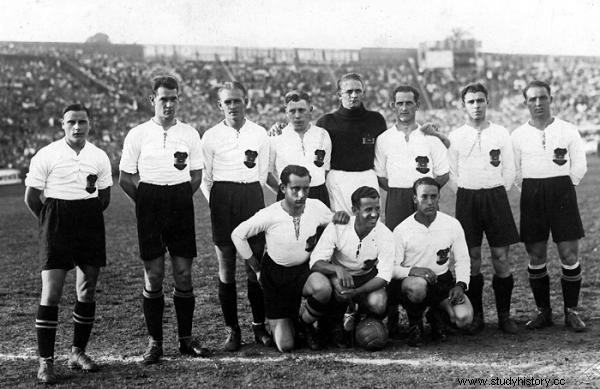
It was the real Wunderteam.
Wunderteam
The architect of the Danube Wunderteam was the Viennese Jew Hugo Meisl, born similarly to Sindelar in the Czech Republic. A man unconsciously in love with football. Stefan Szczepłek writes about him in "My History of Football":
Hugo Meisl (1881–1937), one of the most accomplished people in football. He was a footballer, referee (in 1922 he refereed the first winning match of the Polish national team, with Sweden in Stockholm), FIFA activist, co-creator of the rules of the game, journalist, secretary general of the Austrian PNA, coach of the Austrian national team from 1912 until his death in 1937.
Wunderteam, Meisl's beloved child, reached its peak in the early 1930s. It was an almost invincible team. Only the English managed to stop the Austrians in 1932, after a beautiful and even game, which ended with a score of 4-3.
The real star of this match was Matthias Sindelar, whose game brought the picky island crowd to their knees . The footballer received offers to move to several British clubs but refused. He loved Vienna and could not imagine living elsewhere.
King of Viennese cafes
Wunderteam's streak ended with the Italian World Cup in 1934. The Austrians, who are the main favorites of the event, hit the hosts in the semi-finals. As Szczepłek mentions in his book:
Finally favorites they met in the semi-final match at San Siro in Milan. Two hours earlier it was raining heavily, the players were stuck up to their ankles in the mud, and in these conditions the Austrians' game based on quick, short passes (the so-called Vienna School) was doomed to failure.
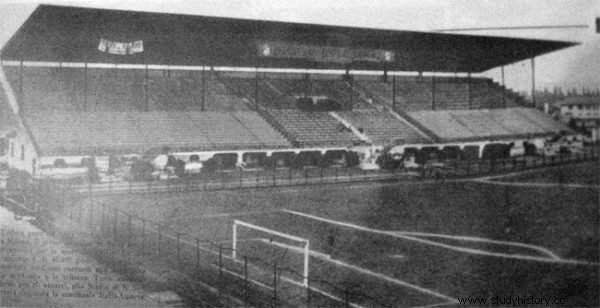
San Siro in 1934, site of the Wunderteam's greatest defeat.
The match was extremely ugly. The Italians contrasted the Viennese grace with a sharp game on the verge of brutality. However, they achieved success by winning 1-0. It was the twilight of the Wunderteam, whose place on the Olympic football for almost a decade was taken by the players of Vittorio Pozzo.
Despite the defeat, Matthias Sindelar's popularity did not diminish. All Vienna loved him. Handsome, elegant, sociable, willingly involved in social campaigns, appeared in commercials, even played episodes in films. He lived his life to the fullest, he loved Viennese cafes where he spent a lot of time. He was one of the most important and popular personalities of the city. Black clouds were gathering over his beloved Vienna.
The Nazis enter Vienna
In 1938, Germany incorporated Austria. Many Viennese euphorically greeted the Nazis. "Sindelar's mother favored the National Socialists and probably greeted the Wehrmacht troops entering Vienna with flowers on the street" - we learn from "My History of Football". However, her son was on the side of the opponents of the new reality. He was a social democrat, had many Jewish friends, and the new brown tint of the city did not suit him at all.
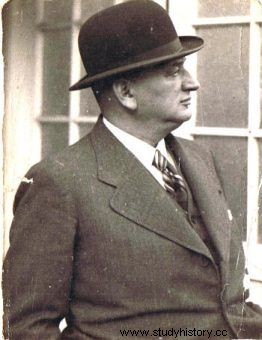
Hugo Meisl was convinced that the key to victory was playing based on passing, not dribbling for the attackers.
When the German and Austrian national teams were combined, Sindelar refused to play for the then coach of the Third Reich team , Sepp Herberger, who was once supposed to lead Germany to victory in the world championship. He got away with age and health problems. However, he appeared in one more international match, which went down in history as Anschlussspiel .
Anschlussspiel
At Prater, in a friendship match, the Austrians saying goodbye to the national team played against Germany. The audience expected a diplomatic draw - the hosts had a big advantage, but they were squandering good opportunities. They wasted ostentatiously - Sindelar and colleagues probably learned that defeating the Germans would be unwelcome by the new authorities.
In the 70th minute, however, the star surprised everyone and defeated the opponents' goalkeeper. Austria won 2-0, and Sindelar performed a provocative dance of joy in front of a tribune of honor made up of Nazi VIPs. Less than ten months later, he was dead.
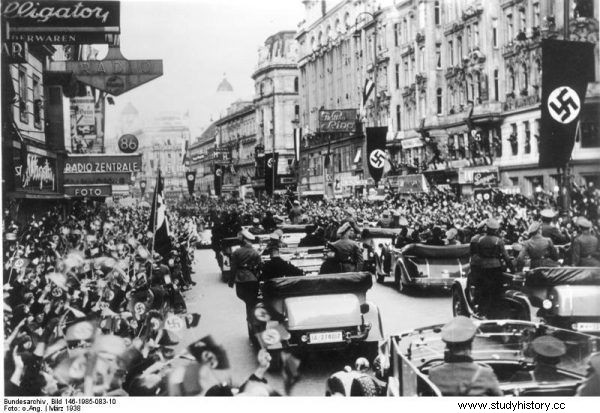
This is how the Austrians welcomed the German army in Vienna in March 1938 (photo:Bundesarchiv, Bild 146-1985-083-10 / CC-BY-SA).
Death in bed with a lover
Sindelara and his Italian mistress of Jewish origin, Camilla Castagnola, were found dead in an apartment in Annagasse on January 23, 1939. The shocking and tragic news quickly spread through the streets of Vienna and immediately sparked a lot of rumors and speculation . "The forensic doctor stated that the cause of death was carbon monoxide poisoning as a result of an accident" - writes Szczepłek.
Many friends of the footballer did not believe the official version. Since then, many theories and hypotheses have arisen to explain the mysterious death of the football genius. The revenge of the Nazis is most often mentioned for which Sindelar, so popular in the city, became a growing problem.
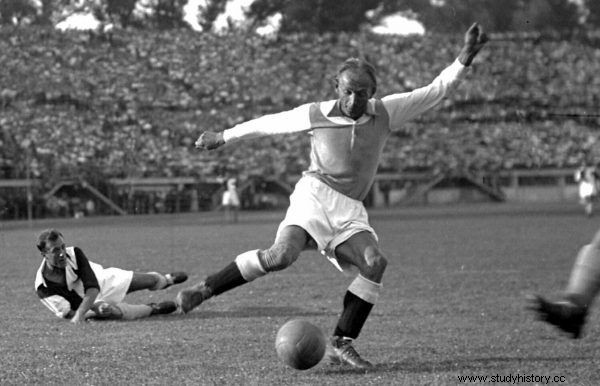
The "man of paper" was the terror of all goalkeepers.
Another version of events is also frequent, according to which Sindelar committed suicide as a result of the depression he suffered from after the end of his career and the invasion of the Nazis into his beloved city. There are also some more fantastic hypotheses, such as the revenge of a betrayed mistress. The mystery of the death of Austria's greatest footballer remains unsolved.
Sources:
Stefan Szczepłek, My history of football , vol. 1, World , Sine Qua Non Publishing House, Krakow 2015.
The author also used materials collected while working on his own book on the history of football.
